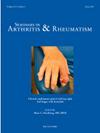Comparative analysis of disease outcomes: Early vs. late transition from psoriasis to psoriatic arthritis
IF 4.6
2区 医学
Q1 RHEUMATOLOGY
引用次数: 0
Abstract
Objectives
Psoriasis typically precedes psoriatic arthritis (PsA). We explored whether the interval between the two diagnoses is associated with PsA phenotype and outcomes.
Methods
We constructed an inception (PsA duration ≤2 years) cohort of patients who developed PsA after psoriasis from a prospective observational cohort. All patients were diagnosed with PsA prior to or at their presentation to the clinic (baseline). We divided the cohort into early and late transition groups based on the median transition period between the diagnoses of psoriasis and PsA of nine years. Features associated with early and late transition at baseline were studied using logistic regression. The impact of early versus late transition on disease activity was assessed using multivariate linear regression, with the 5-year adjusted mean swollen joint count (SJC) as the outcome. The influence on damage was evaluated using Cox regression, with time to radiographic progression as the outcome.
Results
We included 702 patients. Late transition patients were observed to have a younger age at diagnosis of psoriasis and older age at diagnosis of PsA. At baseline, they had higher BMI and PASI and less frequent use of conventional synthetic DMARDs. There was a trend for lower disease activity over time in the late transition group. Radiographic progression was not significantly different.
Conclusion
There were no significant differences in the PsA features at baseline between the two groups. However, on follow-up, there was a trend for lower cumulative disease activity but not in the rate of radiographic progression in the late transition group.
求助全文
约1分钟内获得全文
求助全文
来源期刊
CiteScore
9.20
自引率
4.00%
发文量
176
审稿时长
46 days
期刊介绍:
Seminars in Arthritis and Rheumatism provides access to the highest-quality clinical, therapeutic and translational research about arthritis, rheumatology and musculoskeletal disorders that affect the joints and connective tissue. Each bimonthly issue includes articles giving you the latest diagnostic criteria, consensus statements, systematic reviews and meta-analyses as well as clinical and translational research studies. Read this journal for the latest groundbreaking research and to gain insights from scientists and clinicians on the management and treatment of musculoskeletal and autoimmune rheumatologic diseases. The journal is of interest to rheumatologists, orthopedic surgeons, internal medicine physicians, immunologists and specialists in bone and mineral metabolism.

 求助内容:
求助内容: 应助结果提醒方式:
应助结果提醒方式:


